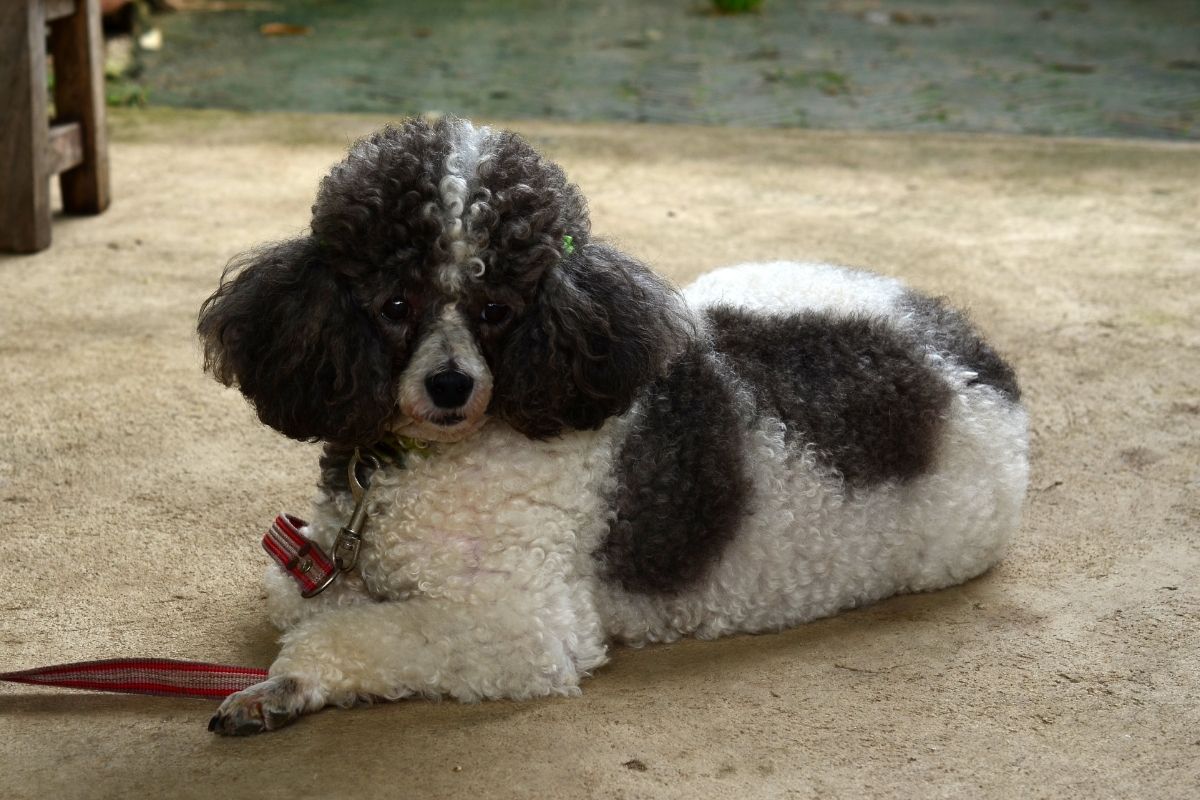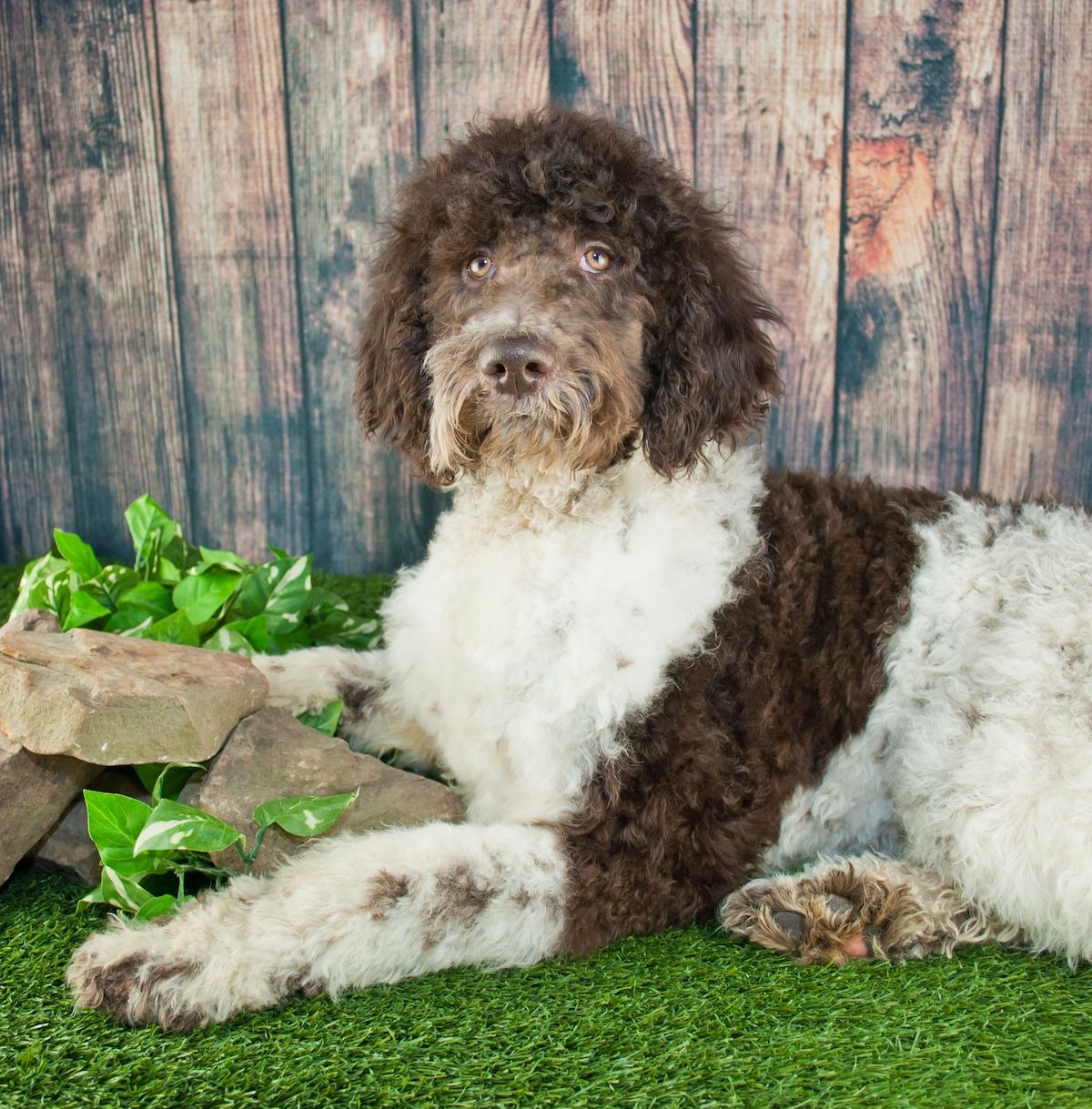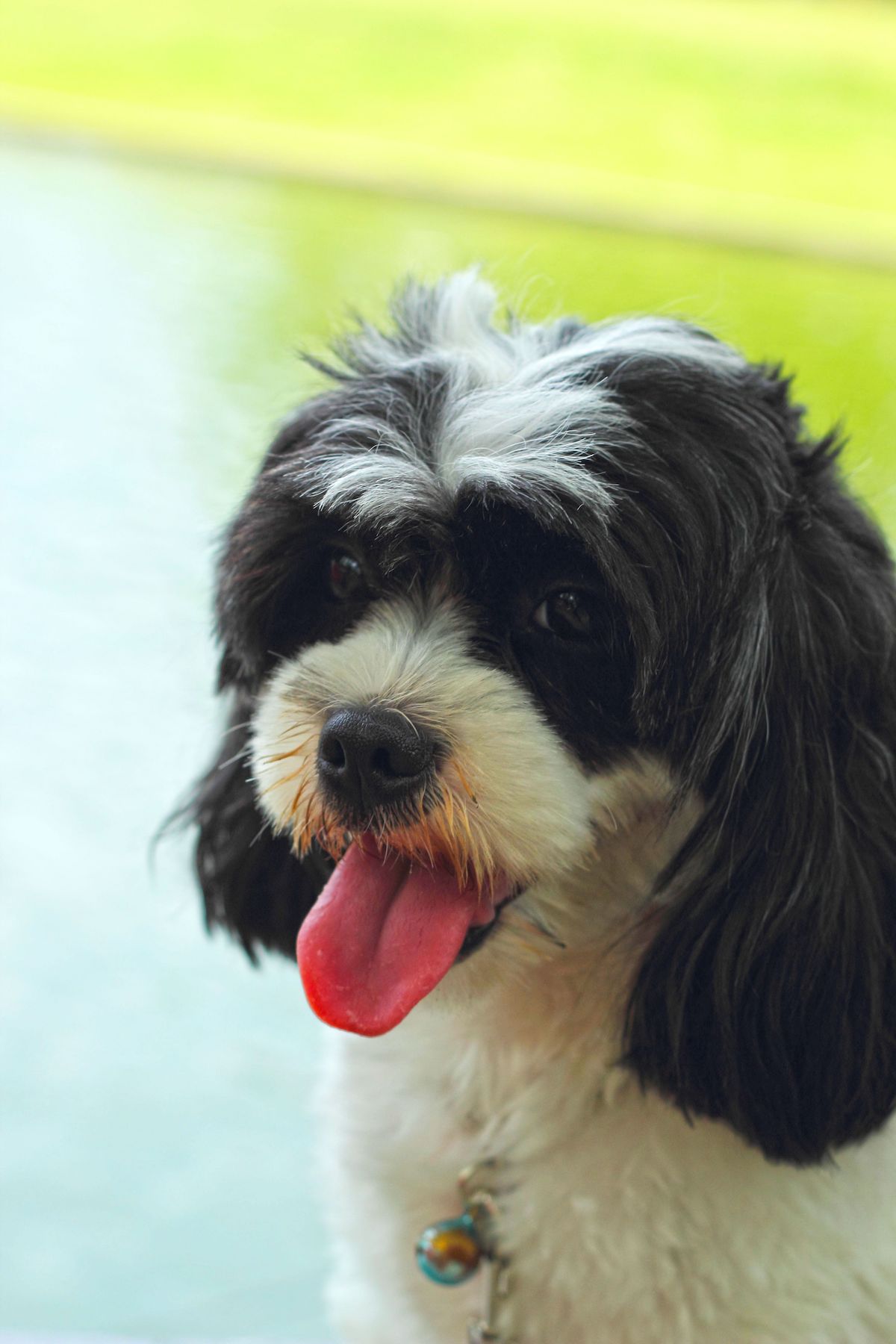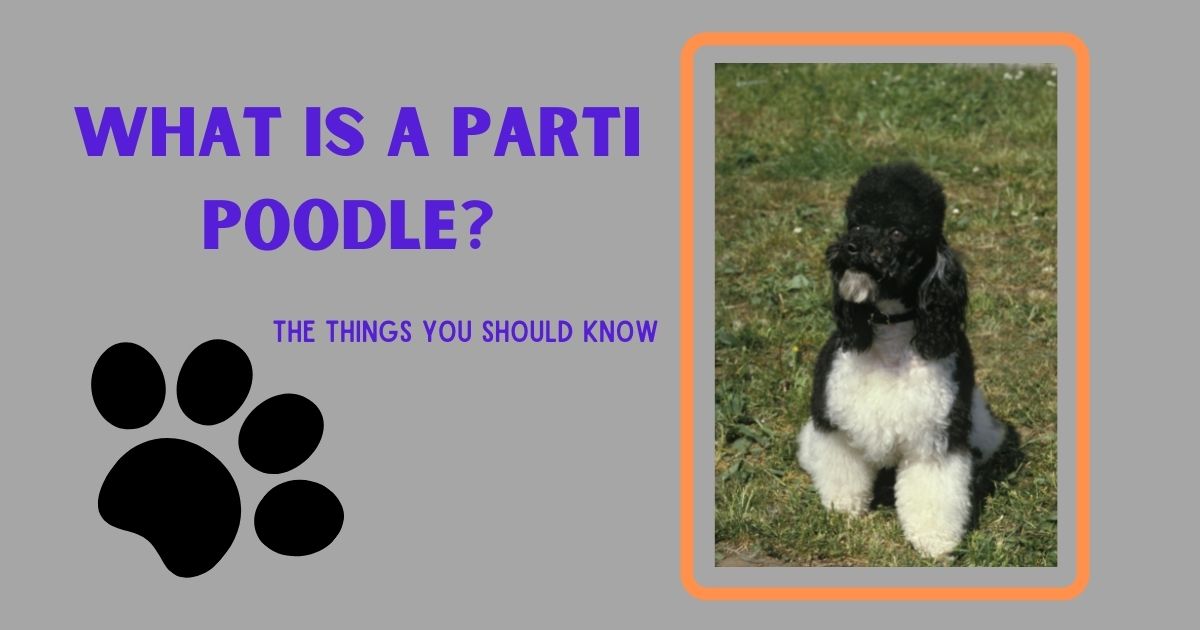Is a Parti Poodle a Pure Breed?
Most people know the solid-colored poodle, but did you know that they also come in a multicolored version? Known as the parti poodle, they’re just as quirky, fun, intelligent and loyal as every other poodle you’ll meet. But, what is a parti poodle?
Are parti poodles even purebred dogs? With poodle-mixes gaining increasing popularity worldwide, we can forgive you for wondering, but parti poodles are poodles just like their “solid” counterparts. Whether they have a pedigree or not can vary, but a parti poodle is just as purebred a poodle as a solid-colored one!
Continue reading to learn more about this fun furry poodle!

What is a Parti Poodle?
Ask anyone what a poodle is, and they’ll probably describe a curly-haired, white dog with a unique haircut. If they know more about the breed, they might also know that they come in other colors, like black, brown, or gray. But poodles, and parti poodles, are so much more than their show cut and solid colors.
The definition of a parti poodle is a poodle with a white base coat that is more than 50% of the coat and a secondary color. This colored “secondary” coat can be anywhere on the dog, and that is one of the things that make parti poodles so much fun- they’re all unique in their looks!
What Does a Parti Poodle Look Like?
Poodles come in lots of different colors, in varying combinations. As we’ve already covered, parti poodles have two colors, each making up roughly 50% of the coat. A well-bred parti poodle should have a very bright white color, with the secondary color having very clearly defined lines without ever fading into the white coat.
The placement of the markings of the secondary color can vary a lot. Some will have their colors spread out throughout their bodies, with others having it more concentrated in one place.
Besides their color varieties, all “types” of poodles also come in 3 (or 4) different sizes:
- Toy poodles: 9.45-11.02 inches (24-28 cm) and 4.41-6.61 pounds (2-3 kg)
- Miniature poodles: 11.02-13.78 inches (28-35 cm) and 6.61-15.43 pounds (3-7 kg)
- (Moyen poodles: 13.78-17.71 inches (35-45 cm) and 15.43-33.07 pounds (7-15 kg))
- Standard poodles: >17.71 inches (45 cm) and 33.07-57.32 pounds (15-26 kg)
We’ve placed the moyen (or medium) poodle in brackets as it is not recognized as a separate breed by the American Kennel Club, but it is its unique breed size in most European pedigrees. (Adding to this, my own Moyen poodle, currently curled up by my feet, would probably argue- if he could, that he does, exist, and he’s a lot smaller than the standard ones we meet!).
I digress. All poodle sizes and colors have the very characteristic curly coat. The “curliness” of the coat can vary from dog to dog, but all should be considered curly. How they look, besides curly, will vary a lot from owner to owner, as there are as many poodle cuts as there are dogs!
Whatever size poodle you have at home, meet or choose to buy, you can be sure that a parti poodle will look good wherever it goes!
What is the Difference Between a Parti Poodle and a Phantom Poodle?
We’ve talked about parti poodles, but you may also have heard of phantom poodles. Phantom poodles and parti poodles seem pretty similar to the untrained eye and are easily mistaken for the other type. However, both are poodles, and both types have two colors.
The main difference is that the secondary color on a parti poodle can appear anywhere on the “main” white coat. On the other hand, Phantom poodles have markings similar to that of a Doberman Pinscher in a particular pattern.
Do Parti Poodles Fade as They Grow?
The colors of poodles can change a lot throughout their lifetimes. As young puppies, colors may blend a lot. This should change as they grow up, with their final color (of both the primary and secondary coat) being finally determined once they are fully mature.
After having reached full maturity, poodles of all types and colors will often start losing some of their color or “fade” to a lighter color as they grow older. Not very unlike how we humans tend to turn gray-haired with age.
The black poodles, or parti poodles with a secondary black color, are especially prone to fading into a more blueish color with time. A red color coat may turn into something similar to an apricot, or even lighter, like a cream color.
Is the Parti Poodle a Rare Occurrence?
Parti poodles are not rare by definition, but they are less common than their solid-colored poodle companions. Don’t be mistaken; two parti poodles bred together will always produce parti colored puppies. However, the breeder cannot predict the combinations of colors and where their markings will be on their body.
A gene called the MITF gene causes the color to appear in random places on the white coat. This gene is a recessive gene to the gene that causes a solid coat color. Explained briefly, this means that the solid color gene is “stronger.”
This, in turn, means that if you breed a solid-colored poodle with a parti poodle, the majority of their puppies are likely to be solid-colored. It may not be accurate for all litters, but statistically, the puppies will more often be solid-colored rather than parti. As a result, fewer parti poodles are then born.
However, pedigree breeders are unlikely to breed two different colors -or at least unlikely to breed a solid with a parti— most of the time. But, one reason why parti poodles may seem “rarer” could be because parti poodles currently cannot be shown in AKC conformation events.
The exclusion from conformation events and shows, of course, led to breeders’ focus being on breeding the solid-colored poodles rather than the parti poodles. Which probably also led to a decline in the numbers of parti poodles.
All in all, it is difficult to determine all the exact reasons as to why there are fewer parti poodles than solid-colored poodles for sure. Still, these charming poodles have been widespread worldwide and are only gaining in popularity!

The Different Parti Poodle Coat Colors
A parti poodle should always be at least 50% white coat, but the options are practically endless for the secondary coat color. Colors include:
- Black
- Cream
- Grey
- Apricot
- Red
- Brown
No two parti poodles are likely to look completely alike!
Does the AKC Recognize Parti Poodles as a Breed?
Yes!
Even though breeders cannot show the parti poodles in the American Kennel Club (AKC) conformation shows, the breed is recognized and bred with pedigrees under the AKC and recognized in many more kennel clubs.
The United Kennel Club (UKC) is the second-largest kennel club in the US and recognizes parti poodles as a poodle-type. The UKC has even allowed them in their confirmation shows since 2004!
However, the FCI kennel club is the world’s oldest kennel club and the most prominent international dog organization globally that organizes a lot of the national kennel clubs, especially within Europe. The FCI itself does not recognize parti poodles as a breed; it only acknowledges solid-colored poodles. However, some national clubs recognize them as a version of a poodle.
The Parti Poodle Temperament
Parti poodles (like all types, sizes, and colors of poodles) are some of the most intelligent dogs in the world. Often called the second-smartest dog breed. Although this is quite hard to measure, and for some debatable, there’s no questioning that poodles are brilliant dogs.
(As an owner of a poodle myself, I will argue that he’s smarter than me!).
Therefore, the incredibly intelligent poodle is easy to train, especially puppies, and ideal for regular obedience training and agility and other dog sports like rally and nose work. Especially the smaller ones are incredibly fast on an agility track, but even the largest standard can give most breeds a run for their money.
Just keep in mind that poodles are highly intuitive and will at times suspect themselves that they are more intelligent than you. Therefore, as a poodle-owner, you need to invest a lot of time into the training. Not because they are challenging to train, but because they might start coming up with their idea of doing stuff.
Poodles are also (most of the time) very friendly, loyal, and playful. But, another word that describes poodles is that they’re goofy! There’s a reason why poodles are used as circus dogs worldwide. They love to do tricks and show off while having lots of fun- almost as much as they love playing! Some poodles can be excellent guard dogs, but it varies a lot.
Parti poodles, and all the other colors, also tend to be very active dogs that need plenty of walks and activity. They need to be exercised. But how much, of course, always need to be adapted to their size, age, and general health!
However, poodles of all colors are really lovely dogs to own. They adore their families and are always happy to play and run around outside, all the while they’re good at calming down and relaxing when indoors. Most of them also love children, making them great family pets- and they’re often smart enough to let the kids think they’re training them!
Caring for Your Parti Poodle
Being so intelligent and active, poodles need to be stimulated, mentally and physically, to stay happy and healthy for many years to come. Don’t forget that your curly best friend, parti poodle or solid colored, is historically a hunting dog. They were bred to run into the water and fetch pray all day long!
Exercise
Of course, a tiny toy parti poodle is unlikely to be able to fetch a shot bird from the water- nor do they need to, to stay healthy. But, they will need some quality walks and run around to spend some of their energy. However, how much exercise a dog requires will depend on their size and how good a shape they are in.
Just remember to over-exercise your dog either, especially if they are a young parti puppy!
Mental Training
We’ve already also discussed that poodles also require mental stimulation. Even the most miniature poodle is likely to enjoy and benefit from attending dog training classes- or plenty of mental training at home. Whatever you enjoy running around an agility track or spend the day doing regular obedience, your poodle will thank you for it!
Feeding
But caring for your parti poodle is more than exercise and training. Feeding your dog high-quality dog food will also ensure that puppies grow at appropriate rates and help keep them healthy once they reach adulthood as well.
If you are in any way in doubt about what you should feed your poodle, contact your veterinarian, and they’ll be able to help you and your pup.
Just remember to take care not to overfeed your precious puppy- or adult poodle. Being overweight presents a severe health risk to all dogs, so keep an eye on your poodle, mainly if they are neutralized, and make sure to weigh it every time you visit your vet.
Health Checks
Talking of vets, your poodle will also need vet visits throughout its life. As a puppy, these will probably be more frequent as they require their puppy immunization shots (vaccines) and general health checks more frequently.
Hopefully, adult dogs will only need to visit the vet for booster jabs and possibly a dental hygiene check. Although, remember, brushing your dog’s teeth daily will minimize the need for dental checks at your vets!
Coat Care
Besides having their teeth brushed, taking care of your parti poodle will also involve taking care of their coat! Whether it is one, two, or more colors, it will need brushing frequently and a haircut now and then as it keeps growing. Please don’t be frightened; it is not as difficult as it sounds or looks. It depends, of course, how you choose to keep your parti poodle!
Just as there are lots of different colors and combinations, there are a lot of different haircuts your poodle can have. The most known one is the show-cut. This is the cut that most people think of when you mention a poodle. But, there are many other options out there.
Some of the most popular cuts tend to be the sports cut or the teddy-bear cut, where the fur is generally kept the same length all over the body. You can choose to take your poodle to a professional dog groomer who will help you with everything from washing and brushing to hair cutting and nail trimming. Or you can attempt to do the grooming at home.
In the end, caring for your parti poodle involves searching for quite a bit of knowledge and learning from others, but it is something everyone can learn!
Health Concerns Associated With Parti Poodles
No matter how well you look after your parti poodle, they can develop health issues. Almost all dogs will at some point need to visit a vet for something more than a booster and general health check- which is why health insurance for your dog is always a good idea!
Parti poodles will be at risk of the same health issues as all other types of poodles.
Progressive Retinal Atrophy (PRA)
PRA is an inherited disease in dogs that will slowly cause blindness over a period. This can be everything from months to years when developing. It can occur in any breed but is most common in toy and miniature poodles.
Often owners start noticing the disease when they discover that their dog is losing the ability to see by walking into things like furniture and such.
A veterinarian diagnoses the disease by examining the back of the eye with an ophthalmoscope to look for signs of retinal degeneration.
As it is an inherited disease, DNA tests are also available to test whether a dog carries the disease’s genes. All reputable breeders should always test their dogs before breeding them or know that their dogs are free of the disease through their genetics.
If a poodle has developed PRA, there is, unfortunately, no effective treatment- the dog will, with time, become completely blind. So, of course, dogs carrying or afflicted by the disease should not be bred.
Cataracts
Certain breeds, including the poodle, inherit some types of cataracts. Cataracts are a disorder where the lens of the eye becomes progressively cloudier. The cloudiness will first cause blurred vision, and it can cause complete blindness with time. It is not painful, but it can be pretty uncomfortable for some dogs to lose sight.
Elbow and Hip Dysplasia
Like many other breeds, poodles can, due to increased breeding, be prone to developing hip and elbow dysplasia- it is most commonly found in the moyen and standard poodle.
Dysplasia of either the elbows or hips can be explained as the joint socket, e.g., the hip socket, not fully covering the “ball” of the upper part of the bone placed within the socket, e.g., the hipbone.
It’s a condition that begins when the dog grows and will get progressively worse. Doing the proper research before breeding dogs can help avoid the condition. Still, even dogs from very healthy parents can develop hip or elbow dysplasia with time, although it is rarer.
It is recommended to have, if not all, at least standard and moyen poodle x-ray screened when they’re roughly 12 months old. By taking pictures of their hips and elbows, the specialized vet can give them a “score” that says something about how likely they are to develop issues as they grow older.
All poodles that are to be bred should be x-rayed beforehand to ensure the breed’s continued hip- and elbow health.
Allergies
Unfortunately, a lot of dogs suffer from allergies. This also goes for the poodle breed. Unlike us humans, dogs will rarely be sneezing or have red eyes when they’re suffering from allergies. Instead, they are far likely to have itchy skin and itchy red ears, which can become extremely painful over time- especially as poodles also tend to have a lot of hair within their ears.
The most common allergies that dogs tend to suffer from are either food allergies, beef or dairy, or environmental allergies, such as grass or dust. Many people worry that their poodles, or other dogs, will suffer from grain allergies- this is luckily an extremely rare type of allergy.
If your dog is suffering from frequent episodes of itching paws and ears, it may be very well worth having your vet look into whether your curly friend is allergic!
Patella Luxation
A luxating patella is common in small dog breeds, particularly toy poodles. It’s a conformation condition where the kneecap (the patella) moves out of its usual location. The most common symptom will be that the dog is “skipping” or running on three legs, then suddenly back on all four like nothing ever happened.
Whether the patella luxation is painful or not depends on the grade of the condition and whether both or only one leg is afflicted.
If you suspect your dog is suffering from patella luxation- or any of the conditions mentioned above- the best thing you can do for your best friend is to contact a veterinarian. A veterinarian will be able to assist you and your dog in planning how to keep your parti poodle as healthy as possible, for as long as possible!

FAQs Related to Parti Poodles
What is the rarest color of the poodle?
Red is currently the rarest color for any poodle to have. The red gene is recessive (weaker) to all the other color genes, except white.
Being a recessive gene means that when you breed a red poodle with all other colored poodles (except for white), the offspring are likely to be the dominant colors- instead of red. Therefore, a red poodle will produce mostly puppies of a different color than red. It also means that a red and white parti poodle is even rarer!
How many poodle colors are there?
The American Kennel Club recognizes eleven colors, solid or in combinations, for poodles. These eleven colors are:
- Apricot
- Blac
- Blue
- Brown
- Cream
- Red
- Silver
- Silver beige
- White
- Café au lait
- Grey
Do Parti Poodles Shed?
Yes, but not very much. Poodles, unlike most breeds, have “hair” instead of fur, which means that they shed significantly less than, for example, a labrador. They do, however, still shed somewhat. This is because their hairs will break over time and get caught in the curly coat. This is one of the reasons that they don’t leave hair all over (it gets stuck in their coat!).
This is also one of the reasons why you should frequently brush and wash your dog to ensure you get all the broken hairs out of the coat.
Are Parti Poodles Hypoallergenic?
The short answer is: It depends on what you are allergic to! Most people who suffer from allergies towards dogs are allergic to the dander attached to the dog hair. As a poodle (almost) doesn’t shed, it is likely to be far more hypoallergenic than almost any other breed out there.
However, if you suffer from saliva, hair, or skin allergies, you might still react. Therefore, it is always an excellent idea to “test” your allergy with a real-life poodle before buying one while just assuming it will be hypoallergenic.
Is a Parti Poodle Expensive to Maintain?
Parti poodles are probably no more expensive to keep than other dog types and certainly no more expensive than their solid-colored counterparts!
If you choose to have a groomer take care of their fur, there will, of course, be some extra expenses in that department. But, if you’re like me and don’t mind your dog sometimes looking a little wonky, it doesn’t have to cost much more than a trimmer, a brush, and some shampoo (and conditioner).
In the end, these fun and festive-looking dogs are an excellent addition to almost any household. Just be careful, the most expensive things about owning a poodle? It’s the fact that you will want another soon after!
